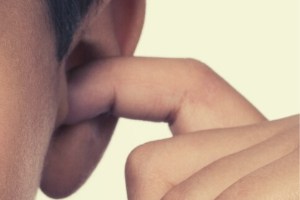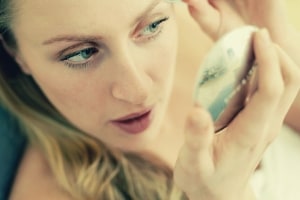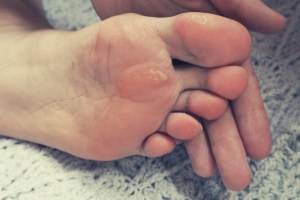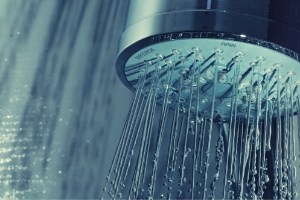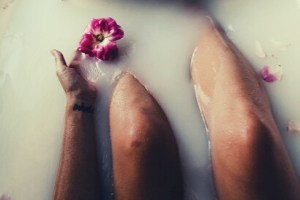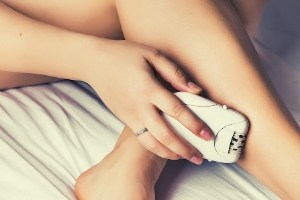I’ve had an ear picking habit and a problem with compulsively cleaning my ears off and on for most of my life. Luckily, I’ve learned techniques to overcome these urges most of the time, which has made a big difference in both my skin and my life overall.
A significant number of people have an ear picking habit. This habit can include picking at and compulsively cleaning the inside of the ear or picking skin on the outer ear. If you have this issue, you’re probably wondering why you have an ear picking habit, if it’s normal, or what you can do about it.
What an Ear Picking Habit Looks Like
An ear picking habit looks differently from person to person, depending on the individual and their preferences.
Often people just pick the skin on their outer ear. This often starts due to dry skin, eczema, a pimple, or some other skin issue and eventually turns into a habit.
Many people are triggered by scabs on their ears. Either the scab will itch or the roughness or unevenness of the scab will give them a bit of anxiety or uneasiness.
People with this problem often have a desire to keep skin even and smooth and anything dry or rough will trigger them to pick. This compulsive picking will make it hard for the scab to ever fully heal and since the scab continues to be on the skin, they continue to pick until it becomes a well ingrained habit.
For other people, their focus is more on the inner ear. For these people, there is often a feeling of discomfort or an itch in their inner ear that they want to relieve.
To accomplish this, people usually resort to inserting objects into their ear. Objects people report using include cotton swabs, needles, bobby pins, tweezers, earpicks, and toothpicks. Some people also obsessively clean their ears with ear drops or peroxide.
Once people pick skin from their ears, a common compulsion is to roll skin between fingers or to eat it.
Why People Pick Ears
In all ear picking habits, the act of picking gives some relief or satisfaction that is reinforcing.
For many people, their ears feel itchy or uncomfortable or the skin is dry. In these cases, ear picking is like scratching an itch. It’s done to relieve discomfort.
At other times, ear picking just feels good.
Why does it feel good to pick or clean ears? Your ears are an erogenous zone so they have tons of nerve endings. This makes rubbing or massaging them stimulating and/or relaxing. Just like a massage feels good, messing with your ears can feel good too. This is often reason enough for many people to develop an ear picking habit.
Another reason many people develop an ear picking habit is because they have problems with self-regulation. Innumerable things can make self-regulation harder, including trauma, depression, anxiety, ADHD, autism, personality disorders, or just too much stress in your life. And ear picking can sometimes help you regulate your body and emotions better.
How does it do this? Well, your ear is connected to your vagus nerve. This is a massive nerve in your body that connects your brain to most of your organs. Stimulating this nerve can send relaxing signals to your body, which helps calm the body. Then the vagus nerve sends signals to your brain that your body is calm. This helps with emotional regulation.
So if you are struggling with self regulation, an ear picking habit is actually something you found accidentally that helped regulate your body and emotions better.
Unfortunately, this method of self-regulation isn’t harmless and should be replaced with less harmful behaviors such as a breathing exercise or cognitive restructuring, which you can learn in cognitive behavioral therapy.
Lastly, sometimes an ear picking habit is just a habit without an underlying reason for it anymore. Usually this happens when it served a purpose at one point in time, like with self-regulation. However, you may have gotten better at self-regulation, but still kept the habit.
This can happen because repeating a behavior over and over again builds neural connections in the brain and nervous system. Once you have those connections built, you can get stuck doing a repeated action over and over again, even if it’s not serving a purpose anymore.
Luckily, your nervous system can adapt and change based upon your behaviors, so you can change these connections by stopping your habit.
Is Ear Picking Normal?
If we include regular users of cotton swabs who use them to itch or clean the inside of their ears even though it’s known that this is bad for your ears, up to half of the population compulsively picks ears from time to time. So ear picking and compulsive ear cleaning is not abnormal by any means.
However, if your ear picking habit has caused damage to your body or emotional distress and you have not been able to stop despite lots of effort, your picking should be concerning to you. In this case, there are therapies and medications that may help you, so it’s a good idea to seek medical advice.
Is Ear Picking Bad?
A common adage among ear doctors is, “do not put anything smaller than your elbow in your ear.” They say this to emphasize the fact that putting anything in your ear, including cotton swabs or your finger, can cause more problems than it solves.
First of all, putting anything in your ear is a great way to push earwax back into the ear, causing it to get backed up. You can also rupture your eardrum which can cause long term damage, hearing loss, or require surgery.
Putting things in your ear can also lead to swimmer’s ear or an ear infection. Rubbing the delicate skin inside your ear causes inflammation, which causes scabs and scar tissue to form. This interferes with your ear’s natural ability to clean itself and fight germs which leads to infection.
And if you think you’re off the hook because you only pick the outer ear, you’re not. Picking at your skin causes chronic irritation in the skin because of constant destruction and rebuilding of cells. And in rare cases, this can trigger squamous cell carcinoma, a slow growing skin cancer.
So whether you are picking inside or outside of your ear, there can be serious consequences to your ear picking habit if you can’t get it under control.
Quick Tips to Stop Picking Your Ears
If you’re struggling with an ear picking habit, it’s best to seek professional help. But to get you started, here’s some quick tips that many people have found useful in beating an ear picking habit:
Fix Underlying Problems
One of the first things you need to do is address any underlying issues that cause irritation, itchiness, or other discomfort in your ears.
If you’re having recurring irritation in your ears, you may have an allergy, dry skin, eczema, infection, or another physical issue that is the cause. Sensory or hearing problems like tinnitus or hearing loss can also cause uncomfortable feelings in the ear, including a blocked feeling or tingling.
Your primary care doctor, ENT, dermatologist, or audiologist may be necessary to get a correct diagnosis and fix the problem.
Stop Using Cotton Swabs
Cotton swabs like Q-tips push wax further into the ear canal which can cause sensations that trigger you.
Many people find that if they stop using cotton swabs for a few weeks or months, the discomfort in their ears gets better over time because the ear is cleaning and healing itself naturally. This reduces all the feelings that trigger picking and compulsive cleaning.
Stop Using Ear Buds
Like cotton swabs, earbuds can irritate the skin in your inner ear. They also can cause ear-wax build up. All these problems will make you more likely to want to pick your ears.
Chew Gum
Chewing gum serves several purposes. First, chewing stimulates the vagus nerve, which is relaxing and helps with self-regulation.
Secondly, chewing gum can slightly stimulate your ears, helping to satisfy your compulsion to touch or pick at them a little. This also helps to move old, dry ear wax out of your ears, which can reduce ear discomfort.
Keep Hands Busy
With all nervous habits, including ear picking, you can sometimes beat them by replacing them with less problematic habits that keep your hands busy. There are tons of ways to do this, including using fidget toys or doodling.
Try Different Soap
Soap is often an overlooked issue with dry, itchy, or irritated skin. But harsh soaps are often a cause of skin conditions. Replace your soap with a gentler one and see if that reduces your urge to pick at your ears.
Sigh
When you feel the urge to pick, scratch, itch, or whatever, let out a long sigh. Then when all that air is out of your lungs, breathe in deeply but naturally.
Then just focus on your breath. Think about how it feels coming in and out of your lungs and how relaxing it is. Don’t try to force anything. Just observe your breath and think about how relaxing it feels to exhale.
This is often enough to get you through the urges and allows you to resist picking until you overcome the habit.
Hide Tools and Triggers
If you use tools like cotton swabs or bobby pins to pick, get rid of them. Seriously. Get them out of your house so you’re not even tempted to use them.
If there are other things that trigger you to pick, get rid of them or keep them out of sight when possible.
Reduce Anxiety and Stress
This is easier said than done, I know. But as I’ve mentioned, picking is often a tool for self-regulation. If you can reduce the anxiety and stress in your life, you will need less help with self-regulation and you will notice the frequency and severity of your picking going down.
Lube Up Your Ears
If you have a scab or wound on your ear, put an ointment on it, such as Neosporin, so that it can heal up quickly. Make sure you put this on multiple times a day, but especially at night.
You can also put vaseline or lotion on your outer ear so that it’s too slick to pick easily. This will deter you from picking because it will be harder and less satisfying.
Related Questions
Why does my child have an ear picking habit?
Ear picking, pulling or rubbing is normal in infants before 4 months of age. They are discovering their bodies. However, excessive picking at the ears or picking or pulling after 12 months of age isn’t common. This could be a sign of infection, allergies, or other medical issues so you should talk to your child’s doctor about it.
Want to remember this? Pin this to your favorite Pinterest board so you can find it later!

References
Deutsches Ärzteblatt International: Otitis Externa
Journal of Clinical Psychopharmacology: Systematic Review of Pharmacological and Behavioral Treatments for Skin Picking Disorder
Journal of Public Health in Africa: Self-Ear Cleaning Practices and the Associated Risk of Ear Injuries and Ear-Related Symptoms in a Group of University Students
Laryngoscope Investigative Otolaryngology: Right Dominance in the Incidence of External Auditory Canal Squamous Cell Carcinoma in the Japanese Population: Does Handedness Affect Carcinogenesis?
Psychosomatics: Psychogenic Excoriation and Cancer
Seattle Children’s Hospital: Ear – Pulling At or Rubbing
